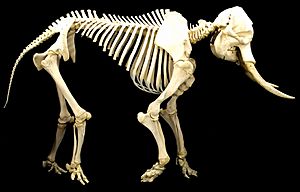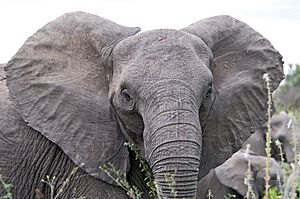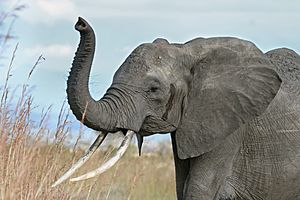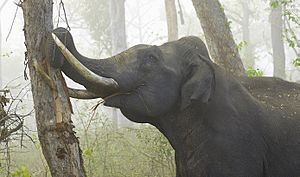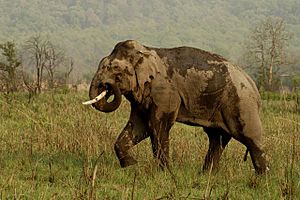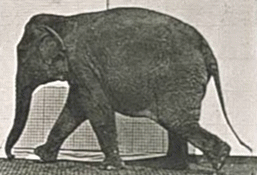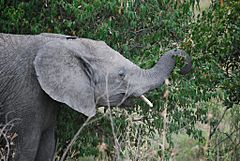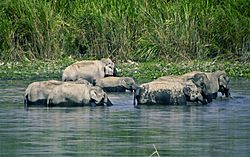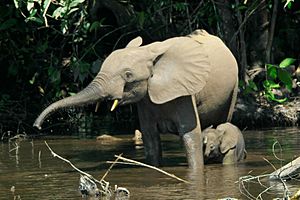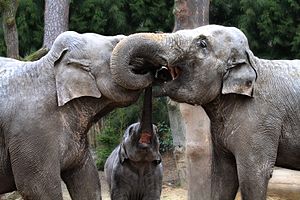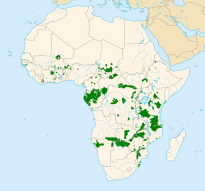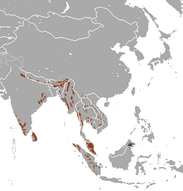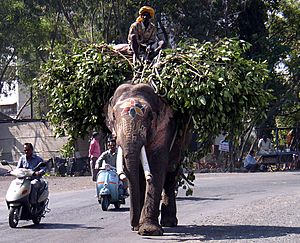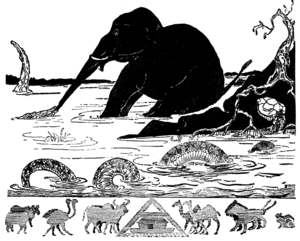Elephant facts for kids
Quick facts for kids Elephants
|
|
|---|---|
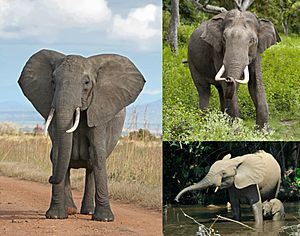 |
|
| From top left to right: the African bush elephant, the Asian elephant and African forest elephant. | |
| Scientific classification | |
| Kingdom: | Animalia |
| Phylum: | Chordata |
| Class: | Mammalia |
| Order: | Proboscidea |
| Family: | Elephantidae |
| Subfamily: | Elephantinae |
| Groups included | |
| Cladistically included but traditionally excluded taxa | |
|
|
Elephants are the largest living land mammals. The largest elephant recorded was one shot in Angola, 1974. It weighed 27,060 pounds (13.5 tons) and stood 13 feet 8 inches tall. Their skin colour is grey.
At birth, an elephant calf may weigh 100 kg (225 pounds). The baby elephant develops for 20 to 22 months inside its mother. No other land animal takes this long to develop before being born.
In the wild, elephants have strong family relationship. Their ways of acting toward other elephants are hard for people to understand. They "talk" to each other with very low sounds. Most elephants sounds are so low, people cannot hear them. But elephants can hear these sounds far away.
Contents
Evolution
Elephants are distantly related to sea cows, which are large aquatic mammals. Early ancestors in the Palaeocene and Eocene were small, semi-aquatic animals. By the Miocene several groups of large mainly forest-dwelling elephants evolved, the gomphotheres and deinotheres. Their teeth show little wear, indicating a diet of soft, nongritty, forest vegetation.
Modern elephants – the actual family Elephantidae – evolved from gomphotheres as the climate became cooler and drier in the Pliocene and Pleistocene. This includes the mammoth and mastodon as well as modern elephants.
The gomphotheres lasted a long time, and were hunted by modern man. There was a change in plant resources, with the reduced forests and extended grassland. This favoured specialist grass feeders over generalist eaters. This change in the dietary supply was one of the factors which forced gomphotheres toward extinction in the late Pleistocene in South America. The remaining population probably succumbed to climatic change and/or human predation around the time of the Holocene margin.
The significant thing about modern elephants (especially Indian elephants) is that they eat grass: they are primarily grazers, rather than browsers. Compared with gomphotheres, the teeth of modern elephants are quite different.
Description
Elephants are the largest extant terrestrial animals. African elephants stand 3–4 m (10–13 ft) and weigh 4,000–7,000 kg (8,800–15,400 lb) while Asian elephants stand 2–3.5 m (7–11 ft) and weigh 3,000–5,000 kg (6,600–11,000 lb). In both cases, males are larger than females.
Among African elephants, the forest form is smaller than the savanna form.
An elephant's skull is resilient enough to withstand the forces generated by the leverage of the tusks and head-to-head collisions.
Because of the size of the head, the neck is relatively short to provide better support.
Elephants are considered dichromats and they can see well in dim light but not in bright light.
The body temperature of an elephant averages 35.9°C (97°F), similar to a human. Like camels, elephants can raise or lower its temperature a few degrees from the average in response to extreme environmental conditions.
Ears
Elephant ears have thick bases with thin tips. The ear flaps, or pinnae, contain numerous blood vessels known as capillaries. To get rid of excess heat from the body, warm blood flows into the capillaries, allowing more heat to be released into the environment. This can occur naturally when the pinnae are still, but the animal can force this effect by flapping them. Larger ear surfaces contain more capillaries, and more heat can be released. Of all the elephants, African bush elephants live in the hottest climates, and thus have the largest ear flaps. Elephants are capable of hearing at low frequencies and are most sensitive at 1 kHz.
Trunk
An elephant's most obvious part is the trunk. The trunk is a very long nose, made from the upper lip. An elephant uses its trunk to grab objects such as food. Though the rest of an elephant's hide is strong and thick, its trunk is very soft and sensitive. Elephants avoid Acacia trees with symbiotic ants because they can bite the inside of an elephant's trunk.
Teeth
Elephants also have tusks. Tusks are large teeth coming out of their upper jaws. A lot of ivory comes from elephant tusks. Ivory traders killed many elephants, so now hunting them is illegal. The trunk is also used when it trumpets. The elephant usually stands still, raises its trunk, and blows. This is a signal to other elephants and wildlife.
African elephants are larger and have bigger ears. They are grazers who still do quite a lot of browsing: they eat leaves, branches and grass. These big ears have many veins, which carry blood throughout the body. Biologists think that the blood going through their ears helps African elephants to cool off. The weather is hotter in Africa than in Asia, so it is hard for elephants to stay cool. Female African elephants have tusks, but female Asian elephants do not. African elephants have a low place in their back. African elephants have two "fingers" at the end of their trunks, but Asian elephants only have one. Indian elephants eat mainly grass.
Grass wears down their teeth because it has a high concentration of silica and is very abrasive. Elephants use their teeth in sequence, not all at once. This means that, at any time, they only have one tooth in each jaw, a total of four.
In total, they have 24 teeth: 12 front teeth, called premolars, and 12 back teeth, called molars. When the last molar wears out, the elephant dies because it cannot eat. They can live for about 70 years. But in a zoo or circus, people can keep elephants alive by feeding them soft food.
Tusks
The tusks of an elephant are modified incisors in the upper jaw. They replace deciduous milk teeth when the animal reaches 6–12 months of age and grow continuously at about 17 cm (7 in) a year.
Tusks serve multiple purposes. They are used for digging for water, salt, and roots; debarking or marking trees; and for moving trees and branches when clearing a path. They serve as weapons when fighting, both for offence and defence, and protecting the trunk.
Like humans, who are typically right- or left-handed, elephants are usually right- or left-tusked. The dominant tusk, called the master tusk, is generally more worn down, as it is shorter with a rounder tip. For the African elephants, tusks are present in both males and females, and are around the same length in both sexes, reaching over 3 m (10 ft), but those of males tend to be thicker. In the Asian species, only the males have large tusks. Female Asians have very small ones, or they are absent altogether.
The ivory of African forest elephants appear to be the hardest and most elastic. Hunting for elephant ivory in Africa may be leading to natural selection for shorter tusks.
Skin
An elephant's skin is generally very tough, at 2.5 cm (1 in) thick on the back and parts of the head.
Young elephants have brownish or reddish hair, especially on the head and back.
Normally the skin of an Asian elephant is covered with more hair than its African counterpart.
Elephants typically have grey skin, but African elephants look brown or reddish after wallowing in coloured mud.
Although tough, an elephant's skin is very sensitive. Without regular mud baths to protect it from burning, insect bites and moisture loss, an elephant's skin suffers serious damage. After bathing, the elephant will usually use its trunk to blow dust onto its body and this dries into a protective crust.
Legs, locomotion and posture
To support the animal's weight, an elephant's limbs are positioned more vertically under the body than in most other mammals.
Since the limb bones are placed on top of each other and under the body, an elephant can stand still for long periods of time without using much energy.
The circular feet of an elephant have soft tissues or "cushion pads" beneath the manus or pes. These pads help to distribute the weight of the animal.
As many as five toenails can be found on both the front and hind feet. Elephants appear to have a sesamoid, an extra "toe" similar in placement to a giant panda's extra "thumb", that helps support and distribute their weight.
Elephants can move both forwards and backwards, but cannot trot, jump, or gallop. They use only two gaits when moving on land, the walk and a faster gait similar to running. In walking, the legs act as pendulums, with the hips and shoulders rising and falling while the foot is planted on the ground. With no "aerial phase", the fast gait does not meet all the criteria of running, although the elephant uses its legs much like other running animals, with the hips and shoulders falling and then rising while the feet are on the ground. Fast-moving elephants appear to 'run' with their front legs, but 'walk' with their hind legs and can reach a top speed of 18 km/h (11 mph). At this speed, most other quadrupeds are well into a gallop, even accounting for leg length. Spring-like kinetics could explain the difference between the motion of elephants and other animals.
When moving, the cushion pads expand and contract, and reduce both the pain and noise that would come from a very heavy animal moving.
Elephants are capable swimmers. They have been recorded swimming for up to six hours without touching the bottom, and have travelled as far as 48 km (30 mi) at a stretch and at speeds of up to 2.1 km/h (1 mph). While they may doze off while standing, elephants usually sleep lying down.
Behaviour
The African bush elephant can be found in habitats as diverse as dry savannas, deserts, marshes, and lake shores, and in elevations from sea level to mountain areas above the snow line. Forest elephants mainly live in equatorial forests, but will enter gallery forests and ecotones between forests and savannas. Asian elephants prefer areas with a mix of grasses, low woody plants and trees, primarily inhabiting dry thorn-scrub forests in southern India and Sri Lanka and evergreen forests in Malaya. Elephants are herbivorous and will eat leaves, twigs, fruit, bark and roots. African elephant are mostly browsers while Asian elephants are mainly grazers. They can consume as much as 150 kg (330 lb) of food and 40 L (11 US gal) of water in a day. Elephants tend to stay near water sources. Major feeding bouts take place in the morning, afternoon and night. At midday, elephants rest under trees and may doze off while standing. Sleeping occurs at night while the animal is lying down. Both males and family groups typically move 10–20 km (6–12 mi) a day, but distances as far as 90–180 km (56–112 mi) have been recorded in the Etosha region of Namibia. They go on seasonal migrations in search of food, water and mates. At Chobe National Park, Botswana, elephant herds travel 325 km (202 mi) to visit the river when the local waterholes dry up.
Because of their large size, elephants have a huge impact on their environments and are considered keystone species. Their habit of uprooting trees and undergrowth can transform savannas into grasslands; when they dig for water during drought, they create waterholes that can be used by other animals. They can enlarge waterholes when they bathe and wallow in them. At Mount Elgon, elephants "excavate" caves that are used by ungulates, hyraxes, bats, birds and insects. Elephants are important seed dispersers; in particular, ingestion and defecation of seeds by African forest elephants tends to have either no effect or a positive effect on their germination and they are typically dispersed in large amounts over great distances. In Asian forests, large seeds require giant herbivores like elephants and rhinoceros for transport and dispersal. This ecological niche cannot be filled by the next largest herbivore, the tapir. Because most of the food they eat goes undigested, their dung can provide food for other animals, such as dung beetles and monkeys. Elephants can have a negative impact on ecosystems. At Murchison Falls National Park in Uganda, the overabundance of elephants has threatened several species of small birds that depend on woodlands. In addition, their weight can compact the soil, which causes the rain to run off, leading to erosion.
The size of adult elephants makes them nearly invulnerable to predators. Calves may be preyed on by lions, spotted hyenas, and wild dogs in Africa and tigers in Asia. The lions of Savuti, Botswana, have adapted to hunting elephants during the dry season, and a pride of 30 lions has been recorded killing individuals between the ages of four and 11 years. Elephants typically coexist peacefully with other herbivores, which will usually stay out their way. Some aggressive interactions between elephants and rhinoceros have been recorded. At Aberdare National Park, Kenya, a rhino attacked an elephant calf and was killed by the other elephants in the group. At Hluhluwe–Umfolozi Game Reserve, South Africa, introduced young orphan elephants went on a killing spree that claimed the lives of 36 rhinos during the 1990s, but ended with the introduction of older males. Elephants tend to have high numbers of parasites, particularly nematodes, when compared to other herbivores. This is due to lower predation pressures that would otherwise kill off many of the individuals with significant parasite loads.
Family life
A female elephant will have a single baby (called a "calf") every four or five years. Calves are born 85 cm (33 in) tall and weigh around 120 kg (260 lb). An elephant's gestation lasts about 22 months. Another female elephant often stays with the new mother until its baby is born. The newborn elephant can often stand within a half hour after it is born. Mother elephants touch their babies gently with their trunks. It takes a baby a year or more to control its trunk and learn its many uses.
Baby elephants nurse for the first two years of their lives. After it is born, the first thing that the baby does is wobble in search of its mother's milk. It drinks about 10 liters of milk every day.
Elephants have long lifespans, reaching 60–70 years of age. Lin Wang, a captive male Asian elephant, lived for 86 years.
Communication
Touching is an important form of communication among elephants. Individuals will greet each other by stroking or wrapping their trunks. Older elephants use trunk-slaps, kicks and shoves to discipline younger ones.
Elephants will try to appear more threatening by raising their heads and spreading their ears. They may add to the display by shaking their heads and snapping their ears, as well as throwing dust and vegetation. They are usually bluffing when performing these actions. Excited elephants may additionally raise their trunks.
Elephants produce a number of sounds. Perhaps the most well known is the trumpet, which is made during excitement, distress or aggression. Fighting elephants may roar or squeal, and wounded ones may bellow.
Intelligence and cognition
Elephants are among the most intelligent species; their psychology is comparable to primates. They exhibit mirror self-recognition, an indication of self-awareness and cognition that has also been demonstrated in some apes and dolphins.
An Asian elephant was recorded modifying branches and using them as flyswatters. Tool modification by these animals is not as advanced as that done by chimpanzees.
Elephants are popularly thought of as having an excellent memory. This could have a factual basis; they possibly have cognitive maps to allow them to remember large-scale spaces over long periods of time. In addition, individuals appear to be able to keep track of the current location of their family members.
Conservation issues
Status
Both African and Asian elephants are endangered species.
African elephants receive some legal protection in every country where they are found. However, 70% of their range exists outside protected areas. Conservation efforts in some areas have led to more elephants.
Large-scale culling (legal killing) ceased in 1988, when Zimbabwe stopped doing it. In 1989, trade in elephants and their products (ivory, meat) was made illegal. Appendix II status (which allows restricted trade) was given to elephants in Botswana, Namibia and Zimbabwe in 1997 and South Africa in 2000. In some countries, sport hunting of the animals is legal: Botswana, Cameroon, Gabon, Mozambique, Namibia, South Africa, Tanzania, Zambia, and Zimbabwe have export quotas for elephant trophies. The IUCN estimates a total of around 440,000 individuals for 2012.
The total population of Asian elephants is about 40,000–50,000 (a rough estimate). Around half of the population is in India. Although Asian elephants are declining in numbers overall, particularly in Southeast Asia, the population in the Western Ghats may be increasing.
Threats
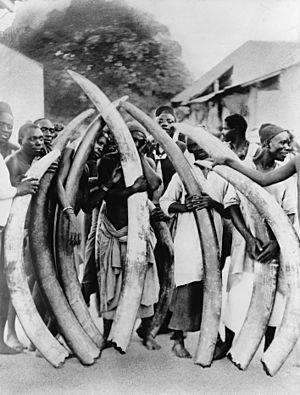
The poaching of elephants for their ivory, meat and hides has been one of the major threats to their existence. Historically, numerous cultures made ornaments and other works of art from elephant ivory, and its use rivaled that of gold. Hunting for ivory contributed to the African elephant population decline in the late 20th century. This prompted international bans on ivory imports, starting with the United States in June 1989, and followed by bans in other North American countries, western European countries, and Japan. Around the same time, Kenya destroyed all its ivory stocks. CITES approved an international ban on ivory that went into effect in January 1990.
Following the bans, unemployment rose in India and China, where the ivory industry was important economically. By contrast, Japan and Hong Kong, which were also part of the industry, were able to adapt and were not badly affected. Zimbabwe, Botswana, Namibia, Zambia, and Malawi wanted to continue the ivory trade and were allowed to, since their local populations were healthy, but only if their supplies were from elephants that had been culled or died of natural causes. The ban allowed the African elephant to recover in parts of Africa. In January 2012, hundreds of elephants in Bouba Njida National Park, Cameroon, were killed by Chadian raiders. This has been called "one of the worst concentrated killings" since the ivory ban. Asian elephants are potentially less vulnerable to the ivory trade, as females usually lack tusks. Still, members of the species have been killed for their ivory in some areas, such as Periyar National Park, India.
Other threats to elephants include habitat destruction and fragmentation, which further lead to direct conflicts with humans. The Asian elephant lives in areas with some of the highest human populations. Because they need larger amounts of land than other sympatric terrestrial mammals, they are the first to be affected by human encroachment. In extreme cases, elephants may be confined to small islands of forest among human-dominated landscapes. In addition, elephants cannot coexist with humans in agricultural areas due to their size and food requirements. Elephants commonly trample and consume crops, which contributes to conflicts with humans, and both elephants and humans have died by the hundreds as a result. Mitigating these conflicts is important for conservation.
Elephants and humans
Working animal
Elephants have been working animals since at least the Indus Valley Civilization and continue to be used in modern times, with 13,000–16,500 working elephants employed in Asia as of 2000. These animals are typically captured from the wild when they are 10–20 years old, when they can be trained quickly and easily, and will have a longer working life. They were traditionally captured with traps and lassos, but since 1950, tranquillisers have been used as they are potentially less harsh. Elephants perform tasks such as hauling loads into remote areas, moving logs into trucks, transporting tourists around national parks, pulling wagons and leading religious processions.
Warfare

Elephants were considered formidable instruments of war in antiquity. They were equipped with armour to protect their sides, and their tusks were given sharp points of iron or brass if they were large enough. War elephants were trained to grasp an enemy soldier and toss him to the person riding on them or to pin the soldier to the ground and impale him.
Zoos and circuses
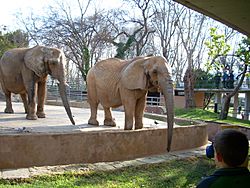
Elephants were historically kept for display in the menageries of Ancient Egypt, China, Greece and Rome. The Romans in particular pitted elephants against humans and other animals in gladiator events. In the modern era, elephants have traditionally been a major part of zoos and circuses around the world. In circuses, they are be trained to preform numerous tricks. As of 2000, around 1,200 Asian and 700 African elephants are kept in zoos and circuses. The largest captive population is in North America, which has an estimated 370 Asian and 350 African elephants. About 380 Asians and 190 Africans are known to exist in Europe, and Japan has around 70 Asians and 67 Africans. Most African elephants in zoological gardens are bush elephants. Some in Europe, Japan and Africa, though, house forest elephants.
Keeping elephants in zoos has been met with some controversy. Proponents of zoos argue that they offer researchers easy access to the animals and provide money and expertise for preserving their natural habitats, as well as safekeeping for the species. Critics claim that the animals in zoos are under physical and mental stress.
Cultural depictions
Elephants have been represented in art since Paleolithic times. Africa in particular contains many rock paintings and engravings of the animals, especially in the Sahara and southern Africa.
In the Far East, the animals are depicted as motifs in Hindu and Buddhist shrines and temples.
Elephants were often difficult to portray by people with no first-hand experience with them. The ancient Romans, who kept the animals in captivity, depicted anatomically accurate elephants on mosaics in Tunisia and Sicily.
At the beginning of Middle Ages, when Europeans had little to no access to the animals, elephants were portrayed more like fantasy creatures. They were often depicted with horse- or bovine-like bodies with trumpet-like trunks and tusks like a boar; some were even given hooves. Elephants were commonly featured in motifs by the stonemasons of the Gothic churches. As more elephants began to be sent to European kings as gifts during the 15th century, depictions of them became more accurate, including one made by Leonardo da Vinci.
Despite this, some Europeans continued to portray them in a more stylised fashion. Max Ernst's 1921 surrealist painting The Elephant Celebes depicts an elephant as a silo with a trunk-like hose protruding from it.
Elephants have been the subject of religious beliefs. The Mbuti people believe that the souls of their dead ancestors resided in elephants. Similar ideas existed among other African tribes, who believed that their chiefs would be reincarnated as elephants. During the 10th century AD, the people of Igbo-Ukwu buried their leaders with elephant tusks. The animals' religious importance is only totemic in Africa but is much more significant in Asia. In Sumatra, elephants have been associated with lightning. Likewise in Hinduism, they are linked with thunderstorms as Airavata, the father of all elephants, represents both lightning and rainbows. One of the most important Hindu deities, the elephant-headed Ganesha, is ranked equal with the supreme gods Shiva, Vishnu, and Brahma. Ganesha is associated with writers and merchants and it is believed that he can give people success as well as grant them their desires. In Buddhism, Buddha is said to have been a white elephant reincarnated as a human. In Islamic tradition, the year 570, when the Prophet Muhammad was born, is known as the Year of the Elephant. Elephants were thought to be religious themselves by the Romans, who believed that they worshipped the sun and stars.
The use of the elephant as a symbol of the US Republican Party began with an 1874 cartoon by Thomas Nast.
As characters, elephants are most common in children's stories. Many stories tell of isolated young elephants returning to a close-knit community, such as "The Elephant's Child" from Rudyard Kipling's Just So Stories, Disney's Dumbo and Kathryn and Byron Jackson's The Saggy Baggy Elephant. Other elephant heroes include Jean de Brunhoff's Babar, David McKee's Elmer and Dr. Seuss's Horton.
Images for kids
-
Parable of the elephant and the blind monks; illustrated by Hanabusa Itchō. (Ukiyo-e woodcut, 1888)
See also
 In Spanish: Elephantidae para niños
In Spanish: Elephantidae para niños



